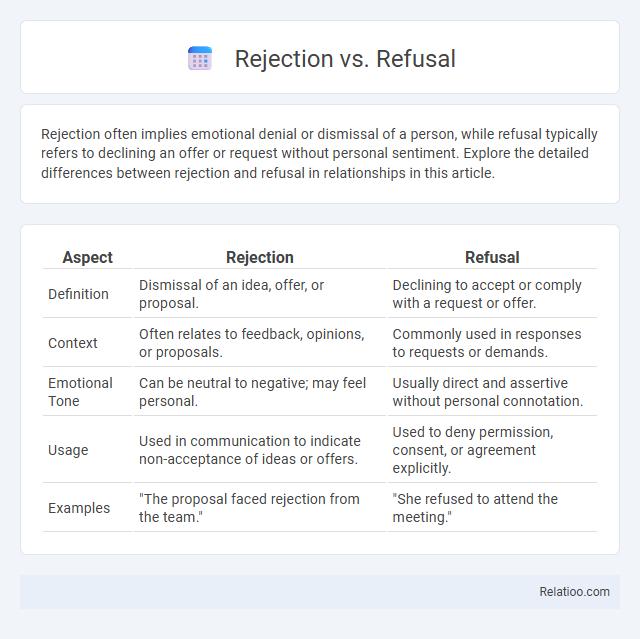Rejection often implies emotional denial or dismissal of a person, while refusal typically refers to declining an offer or request without personal sentiment. Explore the detailed differences between rejection and refusal in relationships in this article.
Table of Comparison
| Aspect | Rejection | Refusal |
|---|---|---|
| Definition | Dismissal of an idea, offer, or proposal. | Declining to accept or comply with a request or offer. |
| Context | Often relates to feedback, opinions, or proposals. | Commonly used in responses to requests or demands. |
| Emotional Tone | Can be neutral to negative; may feel personal. | Usually direct and assertive without personal connotation. |
| Usage | Used in communication to indicate non-acceptance of ideas or offers. | Used to deny permission, consent, or agreement explicitly. |
| Examples | "The proposal faced rejection from the team." | "She refused to attend the meeting." |
Understanding Rejection and Refusal
Understanding rejection involves recognizing it as a response that denies or dismisses an idea, request, or proposal often based on personal or emotional grounds. Refusal, on the other hand, typically represents a clear and direct decision to decline an offer or request, usually for pragmatic or situational reasons. Your ability to distinguish these responses helps navigate interpersonal communication effectively.
Definitions: Rejection vs Refusal
Rejection involves dismissing or excluding something or someone, often implying a negative evaluation or failure to accept an idea, offer, or person. Refusal specifically means declining to accept or comply with a request, proposal, or demand, highlighting a conscious choice not to agree or participate. Your understanding of these terms can clarify communication, as rejection conveys a broader judgment while refusal centers on intentional denial.
Key Differences Between Rejection and Refusal
Rejection involves dismissing or denying something often based on judgment or evaluation, while refusal is a clear decision to not accept or comply with a request or offer. Your understanding of rejection centers on emotional or social cutoff, whereas refusal emphasizes a practical or deliberate choice. The key difference lies in rejection being more personal or evaluative, and refusal being more transactional or action-based.
Psychological Impact of Rejection and Refusal
Rejection triggers deep emotional responses such as sadness, anxiety, and lowered self-esteem, often leading to a sense of social exclusion and questioning of self-worth. Refusal, while it may elicit disappointment, typically carries less emotional weight since it is perceived as a decision rather than a personal judgment. Understanding these psychological impacts can help you navigate interactions more effectively and build resilience against negative emotional outcomes.
Social Contexts: When to Use Rejection or Refusal
Rejection often involves dismissing ideas, proposals, or people, signaling disapproval in social contexts where acceptance is expected or hoped for, such as personal relationships or social invitations. Refusal typically relates to turning down requests or offers, emphasizing your choice or boundaries without necessarily implying judgment or disapproval. Understanding when to use rejection or refusal helps you communicate clearly and maintain appropriate social dynamics.
Common Scenarios Involving Rejection and Refusal
Rejection often occurs in scenarios such as job applications, loan requests, or romantic advances where an offer or proposal is declined outright due to failure to meet set criteria or preferences. Refusal typically applies to everyday situations like declining invitations, rejecting requests for favors, or opting out of participation based on personal choice or constraints. Both rejection and refusal involve denying something, but rejection is frequently formal or institutional, whereas refusal is more personal and situational.
Communication Strategies for Rejection and Refusal
Rejection involves dismissing ideas or proposals, often carrying emotional weight, while refusal is a straightforward denial of requests or offers without emotional implications; both require clear communication strategies to maintain professionalism and respect. Using empathetic language and providing concise reasons help soften the impact and preserve relationships when conveying rejection or refusal. Your communication can be enhanced by balancing firmness with politeness, ensuring messages are unambiguous yet considerate to promote understanding and minimize conflict.
Cultural Perspectives on Rejection vs Refusal
Rejection and refusal hold distinct meanings across cultures, where rejection often implies a personal or emotional dismissal, while refusal typically denotes a practical or situational decline. In collectivist societies, rejection can carry significant social stigma, affecting relationships and community harmony more severely than in individualist cultures, which may interpret refusal more neutrally as a matter of preference or choice. Understanding these cultural nuances is essential for effective communication and conflict resolution, as perceived intentions behind rejection or refusal vary widely in global contexts.
Constructive Ways to Handle Rejection and Refusal
Rejection and refusal both involve denial but differ in context, with rejection often tied to personal or emotional situations, while refusal relates to declining requests or offers; disapproval, however, expresses negative judgment rather than a direct denial. Constructive ways to handle rejection and refusal include acknowledging your feelings without judgment, seeking feedback to improve, and maintaining open communication to find alternative solutions. Your resilience and proactive approach in these situations foster growth and strengthen relationships despite setbacks.
Summary: Choosing the Right Approach
Rejection, refusal, and disapproval each serve distinct roles in communication and decision-making, with rejection often indicating a firm denial, refusal as a direct decline of offers or requests, and disapproval expressing displeasure or disagreement. Understanding these nuances helps you choose the right approach to convey your message effectively and maintain relationships. Selecting the appropriate term ensures clarity and respects the context of your interaction.

Infographic: Rejection vs Refusal
 relatioo.com
relatioo.com